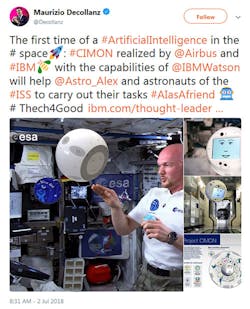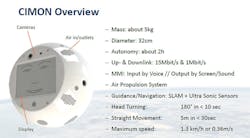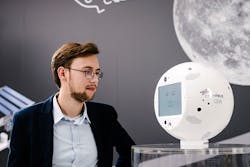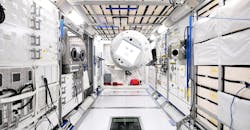Space Station Gets What We All Need: A Robot Sidekick
After 57 years of humans in space, so-called “real” scientists have finally caught on to what has been held to be self-evident by science-fiction writers forever. Every good space mission needs a robot sidekick.
From the lazily named “Robot” from Lost in Space and oddly specific Marvin the Paranoid Android from The Hitchhiker’s Guide to the Galaxy to Futurama’s Bender and Star Wars stalwart R2-D2, these droids’ artificial intelligence and organic chemistry with their fleshy compatriots have proved this time and again. Now, the International Space Station has CIMON, a floating basketball-sized bot to help astronauts complete experiments and even talk about their feelings.
Short for Crew Interactive Mobile Companion, (and inspired by Captain Future), the first-ever mobile intelligent robot assistant aboard the ISS gets its brain power from IBM Watson Services cloud and body from Airbus. German space agency DLR funded the project. A SpaceX Dragon spacecraft propelled Cimon, along with a few tons of supplies and materials, from cape Canaveral on June 29. The cargo arrived July 2.
The floating robot has its own propulsion system, speakers, cameras, and screen to exhibit simple facial expressions or detailed images or video.
“Our long-term goal is to create a new crewmate, a new astronaut assistant that will be used by all the astronauts and be a real helper on the international Space Station,” says Matthias Biniok, the IBM Watson architect who led CIMON’s programming in Germany.
CIMON, which began development in 2016, will assist German astronaut Alexander Gerst, commander of the ISS, on three experiments: providing workflow and instructions for a crystallization study, solving a Rubix cube, and capturing video on a medical procedure.
Here are CIMON’s specs:
Gerst can benefit from CIMON the same you would an Alexa-powered Amazon Echo Show or Jibo when cooking a complicated recipe. It responds to voice commands and dictates instructions, displaying visual aids on its screen when needed. In the kitchen, it’s more of a convenience for when you have flour-caked fingers. In the zero-g environment, this allows the astronaut to stay at the workstation, eliminating the need to swimming back and forth from a laptop to painstakingly search through dozens of pages on a PDF to locate the correct step or procedure. Doing that on terra firma with an ample room to work is hard enough; on the ISS it’s exponentially more difficult, even if you do have the right stuff.
“Time is the most critical value at the ISS and it very expensive, so we try to reduce time-consuming tasks and increase efficiency with CIMON,” Biniok says. “The astronaut can just ask CIMON ‘What’s the next step? What kind of tool do I need?’ Very sophisticated questions, like ‘Why do I need to use Teflon right now and not any other material?’”
The new crewmate will also be the best at following orders. For recording or photography, the rotund robot can precisely position itself on command by voice, adjusting to the right by 30, Biniok explains. It’s like the antithesis of HAL 9000…for now.
One thing CIMON shares with the AI from Space 2001 is its ability to infer human emotions. A psychologist from the Watson team imbued CIMON with the Meyers-Briggs ISTJ, or "logistician," personality. Loyalty, duty and responsibility are the key traits.
“He’s very pragmatic when its about procedures and experiments,” says Biniok, whose favorite sci-fi sidekick is the plucky, incomprehensible astromech R2-D2. “As soon as we go into small talk chit chat and the social component, then he gets very funny and is also a good crewmate.”
It can also shake its head to respond in the affirmative or negative. Through the IBM Tone Analyzer, the AI can also recognize humans’ micro expressions and change its delivery accordingly, like taking a more somber affectation if the astronaut seems sad, Biniok says. Gerst declined this option.
A privacy button on the robot’s side allows the crew to cut CIMON’s feed back to Germany, though CIMON’s display is not a touch screen for a very good reason.
“If you touch, it he would float away,” Biniok says.
CIMON is expected to be a permanent fixture at the ISS, with no plans to come home. There is a second version on Earth, one that may have to comfort Biniok.
“I’m a little sad to let him go,” he says. “I realized I kind of have feelings for this little guy.”
Earthbound Applications
With gravity being a major drag, CIMON wouldn’t work as at home, but IBM Watson Assistant has proven to be an effective sidekick. The Royal Bank of Scotland uses it as a chatbot, and its used for text-to-speech in cars. In all, more than 20 industries have experimented with the AI tech.
Australian energy company Woodside employs the AI to quickly access company data and relay it to employees.
More than 600,000 pages of documentation were “absorbed” by Watson, and after learning worker speech patterns, could supply them with whatever information they needed at the time. Previously, employees spent 80% of their time researching a problem, and 20% fixing it. IBM says that time balance has been reversed with the new solution.
“You have to spend a bit of time training Watson before it will actually work, but it’s been really positive in the operations area,” says Caitlin Bushell, a graduate process engineer for Woodside. “It’s helped our engineers get up to speed very quickly on what has already been done and how the projects were managed in the past. We can learn from the past and there’s no need to reinvent the wheel.”
Four in five workers at Woodside now use Watson daily.
Biniok believes the personality aspect of CIMON can improve efficiency even more, specifically in customer service.
“To a very critical person, you assign a chatbot that can assign critical questions; for a person that needs some enthusiasm, you can assign a very happy chatbot,” he says.
With the Silver Tsunami on the horizon, and many experienced manufacturing workers set to retire, decades of experience, like how to efficiently fix a broken motor or perform a Lock Out/ Tag Out, will be swept away.
“For the people remaining with the company, its very important to get access to the experience of these people and even their personality,” Biniok explains. “That’s something we’re talking about a lot.”
Depending on the use case, Watson Business Solutions can provide a company with a minimum viable product in a month.
About the Author
John Hitch
Senior Editor
John Hitch writes about the latest manufacturing trends and emerging technologies, including but not limited to: Robotics, the Industrial Internet of Things, 3D Printing, and Artificial Intelligence. He is a veteran of the United States Navy and former magazine freelancer based in Cleveland, Ohio.
Questions or comments may be directed to: [email protected]




